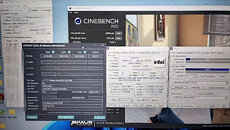- Joined
- Oct 9, 2007
- Messages
- 47,770 (7.42/day)
- Location
- Dublin, Ireland
| System Name | RBMK-1000 |
|---|---|
| Processor | AMD Ryzen 7 5700G |
| Motherboard | Gigabyte B550 AORUS Elite V2 |
| Cooling | DeepCool Gammax L240 V2 |
| Memory | 2x 16GB DDR4-3200 |
| Video Card(s) | Galax RTX 4070 Ti EX |
| Storage | Samsung 990 1TB |
| Display(s) | BenQ 1440p 60 Hz 27-inch |
| Case | Corsair Carbide 100R |
| Audio Device(s) | ASUS SupremeFX S1220A |
| Power Supply | Cooler Master MWE Gold 650W |
| Mouse | ASUS ROG Strix Impact |
| Keyboard | Gamdias Hermes E2 |
| Software | Windows 11 Pro |
The upcoming Core i7-14700K "Raptor Lake Refresh" processor has a core configuration of 8P+12E. That's 8 "Raptor Cove" performance cores, and 12 "Gracemont" efficiency cores spread across 3 E-core clusters. Compared to the i7-13700K, which has been carved out of the "Raptor Lake-S" silicon by disabling 2 out of the 4 available E-core clusters and reducing the L3 cache size to 30 MB from the 36 MB present; the i7-14700K gets an additional E-core cluster, and increases the shared L3 cache size to 33 MB, besides dialing up the clock speeds on both the P-cores and E-cores in comparison to the i7-13700K.
The processor likely has a P-core base frequency of 3.70 GHz, with a 5.50 GHz P-core maximum boost. In comparison, the i7-13700K tops out at 5.40 GHz P-core boost. An alleged i7-14700K engineering sample in the wild has been put through Cinebench R23, where it scores 2192 points in the single-threaded test, and 36296 points in the multi-threaded test. The processor also scored 14988.5 points in the CPU-Z Bench multi-threaded test. Intel is expected to release its 14th Gen Core "Raptor Lake Refresh" desktop processors some time in October 2023.


View at TechPowerUp Main Site | Source
The processor likely has a P-core base frequency of 3.70 GHz, with a 5.50 GHz P-core maximum boost. In comparison, the i7-13700K tops out at 5.40 GHz P-core boost. An alleged i7-14700K engineering sample in the wild has been put through Cinebench R23, where it scores 2192 points in the single-threaded test, and 36296 points in the multi-threaded test. The processor also scored 14988.5 points in the CPU-Z Bench multi-threaded test. Intel is expected to release its 14th Gen Core "Raptor Lake Refresh" desktop processors some time in October 2023.


View at TechPowerUp Main Site | Source






 Intel.
Intel.


